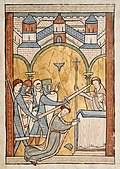Nasal helmet
Nasal helmet refers to a type of combat helmet used in Europe from the Early Middle Ages until the High Middle Ages. Characterized by its single piece of metal that extends down to cover the nose, providing facial protection, the nasal helmet is a significant development in the evolution of medieval armor. It is a precursor to more advanced forms of helmets, such as the Great helm and the Bascinet, which offered more comprehensive protection.
History[edit]
The nasal helmet emerged in the 9th century, possibly as an evolution of earlier helmet types from the Vendel era. Its use spread rapidly across Europe, becoming a common piece of equipment for knights and other mounted warriors by the 11th century. The helmet's simple yet effective design made it popular among the fighting forces of the time. It was used extensively during the Viking Age by Norse warriors, as well as by the Anglo-Saxons, Normans, and other European cultures.
Design[edit]
The primary feature of the nasal helmet is its nasal guard, a projecting piece of metal that covers the nose and offers protection to the central part of the face. The body of the helmet was typically made from a single piece of metal, which was then shaped to fit the wearer's head. This construction method provided both strength and durability. The helmets often included additional elements such as mail curtains or cheek guards for extra protection.
Usage[edit]
Nasal helmets were used not only for military purposes but also as a symbol of status. The quality and decoration of a helmet could reflect the wealth and rank of its wearer. Despite its widespread use, the nasal helmet began to decline in popularity by the 12th century, as more advanced helmet designs offering greater protection and visibility came into use.
Cultural Significance[edit]
The nasal helmet is an iconic piece of medieval warfare and is often depicted in modern media representations of the Middle Ages. Its distinctive shape and design make it easily recognizable and a symbol of the knightly warfare of the period.
See Also[edit]
References[edit]
<references/>
-
Moravian nasal helmet, 11th century
-
St. Wenceslas helmet
-
Nasal helmet
-
Nasal helmet
-
Nasal helmet
Ad. Transform your life with W8MD's Budget GLP-1 injections from $75


W8MD offers a medical weight loss program to lose weight in Philadelphia. Our physician-supervised medical weight loss provides:
- Weight loss injections in NYC (generic and brand names):
- Zepbound / Mounjaro, Wegovy / Ozempic, Saxenda
- Most insurances accepted or discounted self-pay rates. We will obtain insurance prior authorizations if needed.
- Generic GLP1 weight loss injections from $75 for the starting dose.
- Also offer prescription weight loss medications including Phentermine, Qsymia, Diethylpropion, Contrave etc.
NYC weight loss doctor appointmentsNYC weight loss doctor appointments
Start your NYC weight loss journey today at our NYC medical weight loss and Philadelphia medical weight loss clinics.
- Call 718-946-5500 to lose weight in NYC or for medical weight loss in Philadelphia 215-676-2334.
- Tags:NYC medical weight loss, Philadelphia lose weight Zepbound NYC, Budget GLP1 weight loss injections, Wegovy Philadelphia, Wegovy NYC, Philadelphia medical weight loss, Brookly weight loss and Wegovy NYC
|
WikiMD's Wellness Encyclopedia |
| Let Food Be Thy Medicine Medicine Thy Food - Hippocrates |
Medical Disclaimer: WikiMD is not a substitute for professional medical advice. The information on WikiMD is provided as an information resource only, may be incorrect, outdated or misleading, and is not to be used or relied on for any diagnostic or treatment purposes. Please consult your health care provider before making any healthcare decisions or for guidance about a specific medical condition. WikiMD expressly disclaims responsibility, and shall have no liability, for any damages, loss, injury, or liability whatsoever suffered as a result of your reliance on the information contained in this site. By visiting this site you agree to the foregoing terms and conditions, which may from time to time be changed or supplemented by WikiMD. If you do not agree to the foregoing terms and conditions, you should not enter or use this site. See full disclaimer.
Credits:Most images are courtesy of Wikimedia commons, and templates, categories Wikipedia, licensed under CC BY SA or similar.
Translate this page: - East Asian
中文,
日本,
한국어,
South Asian
हिन्दी,
தமிழ்,
తెలుగు,
Urdu,
ಕನ್ನಡ,
Southeast Asian
Indonesian,
Vietnamese,
Thai,
မြန်မာဘာသာ,
বাংলা
European
español,
Deutsch,
français,
Greek,
português do Brasil,
polski,
română,
русский,
Nederlands,
norsk,
svenska,
suomi,
Italian
Middle Eastern & African
عربى,
Turkish,
Persian,
Hebrew,
Afrikaans,
isiZulu,
Kiswahili,
Other
Bulgarian,
Hungarian,
Czech,
Swedish,
മലയാളം,
मराठी,
ਪੰਜਾਬੀ,
ગુજરાતી,
Portuguese,
Ukrainian





